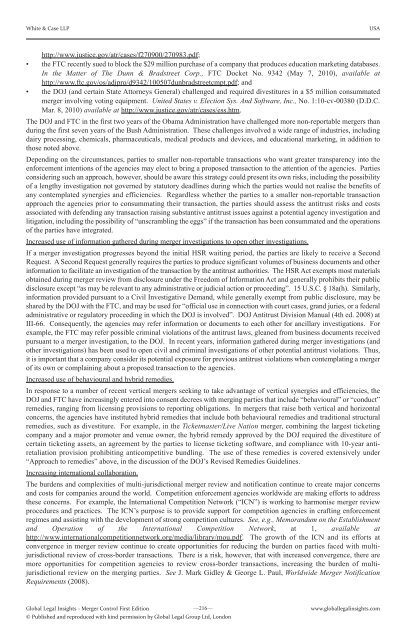Merger Controls First Edition - J Sagar Associates
Merger Controls First Edition - J Sagar Associates
Merger Controls First Edition - J Sagar Associates
You also want an ePaper? Increase the reach of your titles
YUMPU automatically turns print PDFs into web optimized ePapers that Google loves.
White & Case LLP USA<br />
http://www.justice.gov/atr/cases/f270900/270983.pdf;<br />
• the FTC recently sued to block the $29 million purchase of a company that produces education marketing databases.<br />
In the Matter of The Dunn & Bradstreet Corp., FTC Docket No. 9342 (May 7, 2010), available at<br />
http://www.ftc.gov/os/adjpro/d9342/100507dunbradstreetcmpt.pdf; and<br />
• the DOJ (and certain State Attorneys General) challenged and required divestitures in a $5 million consummated<br />
merger involving voting equipment. United States v. Election Sys. And Software, Inc., No. 1:10-cv-00380 (D.D.C.<br />
Mar. 8, 2010) available at http://www.justice.gov/atr/cases/ess.htm.<br />
The DOJ and FTC in the first two years of the Obama Administration have challenged more non-reportable mergers than<br />
during the first seven years of the Bush Administration. These challenges involved a wide range of industries, including<br />
dairy processing, chemicals, pharmaceuticals, medical products and devices, and educational marketing, in addition to<br />
those noted above.<br />
Depending on the circumstances, parties to smaller non-reportable transactions who want greater transparency into the<br />
enforcement intentions of the agencies may elect to bring a proposed transaction to the attention of the agencies. Parties<br />
considering such an approach, however, should be aware this strategy could present its own risks, including the possibility<br />
of a lengthy investigation not governed by statutory deadlines during which the parties would not realise the benefits of<br />
any contemplated synergies and efficiencies. Regardless whether the parties to a smaller non-reportable transaction<br />
approach the agencies prior to consummating their transaction, the parties should assess the antitrust risks and costs<br />
associated with defending any transaction raising substantive antitrust issues against a potential agency investigation and<br />
litigation, including the possibility of “unscrambling the eggs” if the transaction has been consummated and the operations<br />
of the parties have integrated.<br />
Increased use of information gathered during merger investigations to open other investigations.<br />
If a merger investigation progresses beyond the initial HSR waiting period, the parties are likely to receive a Second<br />
Request. A Second Request generally requires the parties to produce significant volumes of business documents and other<br />
information to facilitate an investigation of the transaction by the antitrust authorities. The HSR Act exempts most materials<br />
obtained during merger review from disclosure under the Freedom of Information Act and generally prohibits their public<br />
disclosure except “as may be relevant to any administrative or judicial action or proceeding”. 15 U.S.C. § 18a(h). Similarly,<br />
information provided pursuant to a Civil Investigative Demand, while generally exempt from public disclosure, may be<br />
shared by the DOJ with the FTC, and may be used for “official use in connection with court cases, grand juries, or a federal<br />
administrative or regulatory proceeding in which the DOJ is involved”. DOJ Antitrust Division Manual (4th ed. 2008) at<br />
III-66. Consequently, the agencies may refer information or documents to each other for ancillary investigations. For<br />
example, the FTC may refer possible criminal violations of the antitrust laws, gleaned from business documents received<br />
pursuant to a merger investigation, to the DOJ. In recent years, information gathered during merger investigations (and<br />
other investigations) has been used to open civil and criminal investigations of other potential antitrust violations. Thus,<br />
it is important that a company consider its potential exposure for previous antitrust violations when contemplating a merger<br />
of its own or complaining about a proposed transaction to the agencies.<br />
Increased use of behavioural and hybrid remedies.<br />
In response to a number of recent vertical mergers seeking to take advantage of vertical synergies and efficiencies, the<br />
DOJ and FTC have increasingly entered into consent decrees with merging parties that include “behavioural” or “conduct”<br />
remedies, ranging from licensing provisions to reporting obligations. In mergers that raise both vertical and horizontal<br />
concerns, the agencies have instituted hybrid remedies that include both behavioural remedies and traditional structural<br />
remedies, such as divestiture. For example, in the Ticketmaster/Live Nation merger, combining the largest ticketing<br />
company and a major promoter and venue owner, the hybrid remedy approved by the DOJ required the divestiture of<br />
certain ticketing assets, an agreement by the parties to license ticketing software, and compliance with 10-year antiretaliation<br />
provision prohibiting anticompetitive bundling. The use of these remedies is covered extensively under<br />
“Approach to remedies” above, in the discussion of the DOJ’s Revised Remedies Guidelines.<br />
Increasing international collaboration.<br />
The burdens and complexities of multi-jurisdictional merger review and notification continue to create major concerns<br />
and costs for companies around the world. Competition enforcement agencies worldwide are making efforts to address<br />
these concerns. For example, the International Competition Network (“ICN”) is working to harmonise merger review<br />
procedures and practices. The ICN’s purpose is to provide support for competition agencies in crafting enforcement<br />
regimes and assisting with the development of strong competition cultures. See, e.g., Memorandum on the Establishment<br />
and Operation of the International Competition Network, at 1, available at<br />
http://www.internationalcompetitionnetwork.org/media/library/mou.pdf. The growth of the ICN and its efforts at<br />
convergence in merger review continue to create opportunities for reducing the burden on parties faced with multijurisdictional<br />
review of cross-border transactions. There is a risk, however, that with increased convergence, there are<br />
more opportunities for competition agencies to review cross-border transactions, increasing the burden of multijurisdictional<br />
review on the merging parties. See J. Mark Gidley & George L. Paul, Worldwide <strong>Merger</strong> Notification<br />
Requirements (2008).<br />
Global Legal Insights <strong>Merger</strong> Control <strong>First</strong> <strong>Edition</strong><br />
—216—<br />
© Published and reproduced with kind permission by Global Legal Group Ltd, London<br />
www.globallegalinsights.com


